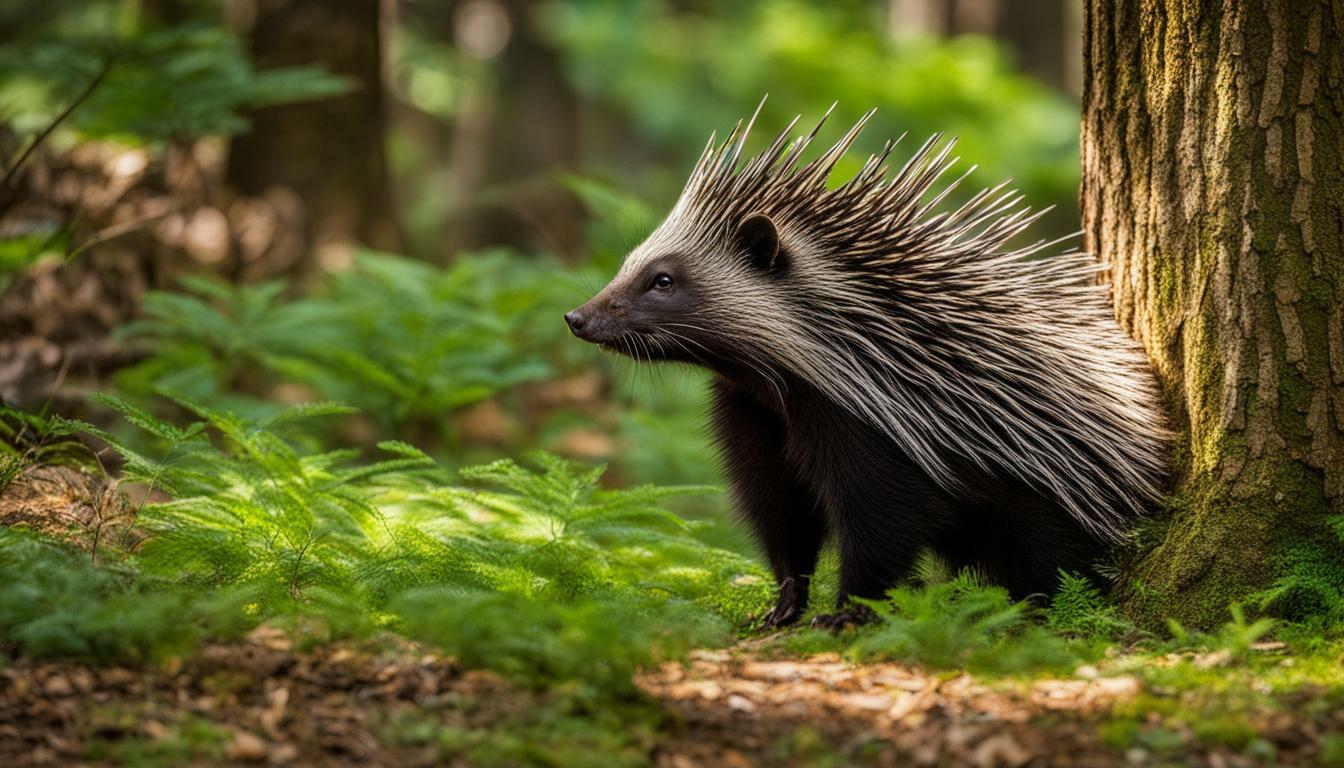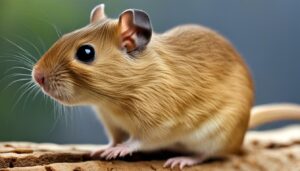Porcupines were once present in Illinois but have disappeared from the state. They used to inhabit the northern part of Illinois, but as forests were cleared for agricultural purposes, their population declined. The porcupine is a common resident of coniferous forests in western and northern North America. It is a heavy-bodied, slow-moving, and awkward rodent known for its sharp, barbed quills for defense. Porcupines rely on caves, rock slides, and thick timber downfalls for shelter. Although porcupines are not currently found in Illinois, they can still be found in other parts of North America.
Key Takeaways:
- Porcupines were once present in Illinois but have disappeared due to forest clearing for agriculture.
- Porcupines are common in coniferous forests in western and northern North America.
- They have sharp, barbed quills for defense and rely on natural shelters.
- Predators of porcupines include coyotes, bobcats, mountain lions, black bears, fishers, martens, and great horned owls.
- While porcupines are not currently found in Illinois, they still inhabit other parts of North America.
Historical Presence of Porcupines in Illinois
Porcupines used to inhabit the northern part of Illinois, but as forests were cleared for agricultural purposes, they disappeared. These fascinating creatures, known for their sharp, barbed quills, were once a common resident of coniferous forests in western and northern North America. They relied on caves, rock slides, and thick timber downfalls for shelter, forming an important part of the ecosystem.
Unfortunately, the clearing of forests in Illinois drastically altered the porcupines’ habitat, leading to their disappearance from the state. This loss of habitat not only impacted the porcupines but also disrupted the delicate balance of Illinois’ wildlife diversity.
Porcupines are not only interesting creatures but also play an essential role in the ecosystem. While they are no longer found in Illinois, they can still be observed in other parts of North America. These unique animals continue to thrive in their natural habitats, contributing to the biodiversity of the region.
Native Animals in Illinois
The disappearance of porcupines in Illinois serves as a reminder of the importance of preserving and protecting the state’s native wildlife. Illinois is home to a diverse range of wildlife species, each playing a crucial role in maintaining the ecological balance. From majestic deer to elusive foxes, these native animals contribute to the beauty and richness of Illinois’ natural heritage.
| Predators of Porcupines in Illinois | Prey |
|---|---|
| Coyotes | Porcupines |
| Bobcats | Porcupines |
| Mountain Lions | Porcupines |
| Black Bears | Porcupines |
| Fishers | Porcupines |
| Martens | Porcupines |
| Great Horned Owls | Porcupines |
Though porcupines may no longer roam the forests of Illinois, exploring the state’s wildlife sanctuaries can provide a chance to observe other native animals. These protected areas offer a glimpse into the diverse wildlife that still calls Illinois home, highlighting the importance of conservation efforts in preserving their habitats.
Description of Porcupines
The porcupine is a heavy-bodied, slow-moving, and awkward rodent known for its sharp, barbed quills for defense. These quills are its most distinctive feature and serve as a deterrent against potential predators. When threatened, the porcupine will raise its quills and make itself appear larger, warning any would-be attackers to stay away.
Porcupines are primarily herbivores, feeding on a diet of bark, leaves, twigs, and other plant materials. Their teeth are specially adapted for gnawing through tough vegetation. Despite their somewhat clumsy appearance, they are excellent climbers and are often found in trees, where they feel safer from predators.
In terms of habitat, porcupines prefer forests with dense vegetation. They rely on caves, rock slides, and thick timber downfalls for shelter and protection. Oftentimes, they will make their dens in hollow trees or burrows they have dug themselves. These habitats provide them with the necessary protection and camouflage they need to survive in the wild.
Physical Characteristics of Porcupines
Porcupines have a stocky build with short legs and a rounded head. They can measure up to 2 feet in length and weigh between 12 to 35 pounds, depending on the species. Their bodies are covered in a coat of thick, wiry hair and quills that range in length from 2 to 4 inches.
| Physical Characteristics | Description |
|---|---|
| Quills | Their quills are sharp, barbed, and modified hairs that cover their backs, sides, and tails. These quills are made of keratin, the same material found in human hair and nails. |
| Coloration | Porcupines have a range of colorations, with some species having darker shades of brown or black, while others have lighter shades of yellow or gray. |
| Tail | Porcupines have a long, muscular tail that helps them maintain balance while climbing and provides additional protection against predators. |
Despite their spiky appearance, porcupines are generally docile creatures and will only use their quills as a last resort. They are known to be solitary animals, coming together only during the mating season. However, their populations have significantly declined in Illinois, making them a rare sight in the state today.
Predators of Porcupines
Porcupines have several natural predators in their habitat, including coyotes, bobcats, mountain lions, black bears, fishers, martens, and great horned owls. These predators play an important role in the ecosystem by controlling the population of porcupines and maintaining a balance in the food chain.
Coyotes are known to be opportunistic hunters and will prey on porcupines if they come across them. They are quick and agile, making them effective in capturing their prey. Similarly, bobcats are skilled hunters and can easily climb trees to reach porcupines. Their sharp claws and agility give them an advantage in hunting these spiky creatures.
Mountain lions, also known as cougars or pumas, are apex predators that can take down larger animals, including deer and elk. While they primarily feed on ungulates, they may also target porcupines if available. Their strength and stealth make them formidable hunters.
Black bears, particularly in the northern regions where porcupines are more prevalent, are known to hunt porcupines. Their strong jaws and sharp teeth allow them to access the porcupine’s flesh without injuring themselves. Additionally, fishers, martens, and great horned owls are also skilled hunters that can overcome the porcupine’s quills to secure a meal.
| Predators of Porcupines | Habitat |
|---|---|
| Coyotes | Wide range across North America, including Illinois |
| Bobcats | Forested areas, including Illinois |
| Mountain Lions | Forest and mountainous regions of North America |
| Black Bears | Forest regions, including northern Illinois |
| Fishers & Martens | Wooded areas of North America, including Illinois |
| Great Horned Owls | Wide range of habitats, including forests |
Current Status of Porcupines in Illinois
While porcupines are not currently found in Illinois, they can still be found in other parts of North America. These unique rodents were once a part of the wildlife diversity in the northern region of Illinois. However, as forests were cleared for agricultural purposes, their habitat diminished, leading to their disappearance from the state.
Porcupines are common residents of coniferous forests in western and northern North America. Their heavy-bodied, slow-moving nature and sharp, barbed quills for defense make them easily recognizable. These quills serve as a deterrent for predators, including coyotes, bobcats, mountain lions, black bears, fishers, martens, and great horned owls, which prey on porcupines.
Porcupines rely on caves, rock slides, and thick timber downfalls for shelter, creating a unique ecological niche within their habitat. Unfortunately, the loss of these natural features due to human activities played a significant role in their disappearance from Illinois. Despite their absence in the state, porcupines can still be found thriving in other parts of North America.
| Predators of Porcupines | Habitat Preferences |
|---|---|
| Coyotes | Coniferous forests |
| Bobcats | Caves |
| Mountain Lions | Rock slides |
| Black Bears | Thick timber downfalls |
| Fishers | |
| Martens | |
| Great Horned Owls |
Wildlife Diversity in Illinois
Illinois is home to a rich variety of native animals, contributing to the state’s wildlife diversity. From the forests and wetlands to the prairies and rivers, Illinois provides various habitats for a wide range of wildlife species. The state’s diverse landscape supports a diverse array of native animals, making it an exciting destination for wildlife enthusiasts and nature lovers.
Among the native animals found in Illinois, you can discover a fascinating array of mammals, birds, reptiles, amphibians, and fish. From large mammals like white-tailed deer and black bears to small critters like the eastern chipmunk and the charming little brown bat, there is no shortage of wildlife to observe and admire.
The rivers and lakes of Illinois are teeming with diverse fish species, including bass, catfish, and perch, providing ample opportunities for fishing enthusiasts. Birdwatchers will be delighted by the abundance of bird species that call Illinois home, such as the vibrant northern cardinal, the majestic bald eagle, and the elusive great blue heron.
Notable Native Animals in Illinois:
- White-tailed deer
- Eastern cottontail rabbit
- Raccoon
- Eastern box turtle
- Painted turtle
Exploring the wildlife sanctuaries and natural areas in Illinois is a fantastic way to experience the state’s wildlife diversity firsthand. From Shawnee National Forest in the south to Starved Rock State Park along the Illinois River, these protected areas offer opportunities to encounter native animals in their natural habitats.
| Wildlife Sanctuary | Location |
|---|---|
| Shawnee National Forest | Southern Illinois |
| Starved Rock State Park | Oglesby, Illinois |
| Crab Orchard National Wildlife Refuge | Marion, Illinois |
Preserving and protecting the wildlife diversity in Illinois is of paramount importance. Conservation efforts continue to play a crucial role in safeguarding the habitats of native animals and ensuring their survival for future generations to enjoy. By promoting awareness and sustainable practices, we can help maintain the delicate balance of Illinois’ ecosystems and protect the unique wildlife that call this state their home.
Factors Leading to Porcupines’ Disappearance in Illinois
The disappearance of porcupines in Illinois can be attributed to the clearing of forests for agricultural purposes. As land was cleared to make way for farming and settlements, the porcupine’s habitat was significantly reduced, leading to their disappearance from the state. Porcupines were once common residents of the northern part of Illinois, but as forests dwindled, so did their population.
These unique rodents depended on the forested areas of Illinois for their survival. They relied on caves, rock slides, and thick timber downfalls for shelter and protection. With the loss of their preferred habitat due to deforestation, porcupines were no longer able to find suitable areas to thrive in Illinois.
Additionally, the clearing of forests disrupted the natural balance of the ecosystem, affecting not just porcupines but many other wildlife species as well. The loss of habitat and the reduction in forested areas had a significant impact on the biodiversity of Illinois, leading to the decline or disappearance of many native animals.
Impact of Forest Clearing on Porcupines and Illinois Wildlife
The clearing of forests for agricultural purposes not only resulted in the disappearance of porcupines but also had far-reaching effects on the Illinois wildlife. The loss of forested areas meant a loss of essential habitat for many native animals, leading to a decline in their populations.
Forest clearing disrupted the natural food chain, as porcupines, being herbivores, played a crucial role in the ecosystem. They helped control vegetation growth through their feeding habits, ensuring a balance between plants and animals. With their disappearance, the unchecked growth of vegetation and the lack of herbivore activity had a cascading effect on other species, leading to further imbalances in the ecosystem.
The disappearance of porcupines in Illinois serves as a reminder of the importance of preserving and protecting natural habitats. Efforts towards habitat conservation, restoration, and public awareness are crucial in ensuring the survival of native wildlife in Illinois and maintaining the state’s ecological diversity.
| Predators of Porcupines | Main Features |
|---|---|
| Coyotes | Known for their intelligence and adaptability, coyotes have a diverse diet and are skilled hunters. |
| Bobcats | With their stealth and agility, bobcats are adept at hunting small mammals, including porcupines. |
| Mountain Lions | As top predators, mountain lions have the strength and speed to capture and prey on porcupines. |
| Black Bears | Black bears are opportunistic omnivores and are capable of hunting porcupines if the opportunity arises. |
| Fishers | Known for their tree-climbing skills, fishers are skilled predators that can prey on porcupines. |
| Martens | Martens have a slender build and are adept climbers, making them capable of hunting porcupines. |
| Great Horned Owls | These nocturnal birds of prey have powerful talons and can capture and consume porcupines. |
Conservation Efforts for Wildlife in Illinois
Various conservation initiatives are underway in Illinois to protect and preserve native wildlife species. The state recognizes the importance of maintaining biodiversity and the ecological balance, and has implemented measures to safeguard the native animals and their habitats.
One such initiative is the Illinois Wildlife Action Plan (IWAP), a comprehensive strategy that aims to conserve and enhance the state’s wildlife diversity. The plan focuses on identifying and addressing the threats faced by native animals, including habitat loss and fragmentation, pollution, invasive species, and climate change.
The IWAP not only serves as a roadmap for conservation efforts, but also promotes community involvement through education, outreach programs, and partnerships with various stakeholders. By raising awareness about the importance of wildlife conservation and engaging the public in citizen science initiatives, Illinois is fostering a culture of stewardship and encouraging active participation in conservation activities.
| Conservation Initiative | Description |
|---|---|
| Illinois Nature Preserves Commission | Established in 1963, the commission works to protect and manage natural areas that support endangered and threatened species, including many native animals in Illinois. |
| Land and Water Conservation Fund | This federal program provides funding for the acquisition and conservation of important wildlife habitats, ensuring the long-term protection of native animals. |
| Wildlife Habitat Grants Program | Administered by the Illinois Department of Natural Resources, this program provides financial assistance to landowners for habitat restoration and enhancement projects that benefit native wildlife. |
These are just a few examples of the numerous conservation initiatives taking place in Illinois. Through collaborative efforts between government agencies, non-profit organizations, and individuals, the state is striving to preserve its rich wildlife heritage for future generations.
Porcupines in North America
Porcupines can be found in various regions of North America, where they play an important role in the ecosystem. These fascinating creatures are known for their sharp, barbed quills that serve as defense mechanisms. They have a heavy-bodied, slow-moving nature that makes them quite unique among rodents. While porcupines are not currently found in Illinois, they used to inhabit the northern part of the state.
In terms of habitat, porcupines are commonly found in coniferous forests in western and northern North America. They rely on caves, rock slides, and thick timber downfalls for shelter. These areas provide them with protection and a suitable environment to thrive. However, as forests were cleared for agricultural purposes in Illinois, porcupines were unable to sustain their presence in the state and gradually disappeared.
Porcupines face a number of predators in their natural habitats. Coyotes, bobcats, mountain lions, black bears, fishers, martens, and great horned owls are known to be among the predators that prey on porcupines. These predators have developed specific hunting techniques to tackle the porcupine’s quills.
Significance of Porcupines in the Ecosystem
Porcupines play an important role in the ecosystem as they help maintain balance in forested areas. They are considered a keystone species, meaning they have a disproportionate impact on their environment compared to their abundance. By feeding on tree bark, buds, and branches, porcupines contribute to the natural pruning of trees, which in turn stimulates new growth and promotes biodiversity.
Predominance in Other Parts of North America
While porcupines are no longer found in Illinois, they can still be found in other parts of North America. These regions include the western and northern areas of the continent, where suitable habitats support their existence. To observe these intriguing creatures in their natural habitats, exploring wildlife sanctuaries in neighboring states such as Wisconsin and Michigan can provide opportunities to witness porcupines in action.
| Predators of Porcupines | Main Hunting Technique |
|---|---|
| Coyotes | Flipping the porcupine over to access the vulnerable belly |
| Bobcats | Pouncing and biting the porcupine’s face and neck |
| Mountain Lions | Aiming for a swift, fatal bite to the head or neck |
| Black Bears | Targeting the porcupine’s quill-free belly area |
| Fishers | Attacking from the back or sides, avoiding the sharp quills |
| Martens | Targeting the face and throat, where the quills are less abundant |
| Great Horned Owls | Swooping down from above to grasp the porcupine |
Exploring Illinois Wildlife Sanctuaries
Illinois offers several wildlife sanctuaries that provide opportunities to observe native animals, including the elusive porcupine. These sanctuaries are dedicated to conservation and are home to a diverse range of wildlife species. If you’re interested in exploring Illinois’ natural beauty and encountering native animals, here are some recommended wildlife sanctuaries to visit:
1. Shawnee National Forest
Located in southern Illinois, Shawnee National Forest encompasses over 280,000 acres of diverse habitats. It offers numerous trails and lookout points where you can spot various native animals in their natural environment. Keep an eye out for signs of porcupines, such as chewed tree bark or their characteristic quills.
2. Cache River State Natural Area
Cache River State Natural Area is known for its wetlands and unique flora and fauna. Explore the boardwalks and trails that wind through the swampy areas, and you may have a chance encounter with wildlife like beavers, river otters, and migratory birds. While porcupines may be elusive, the sanctuary’s diverse ecosystems make it an ideal habitat for various species.
3. Starved Rock State Park
Situated along the Illinois River, Starved Rock State Park is a popular destination for outdoor enthusiasts. The park features towering sandstone canyons, waterfalls, and scenic overlooks. As you hike through its trails, you may spot a variety of wildlife, such as deer, foxes, and numerous bird species. Although porcupines are not commonly sighted in the park, their native habitat provides a conducive environment for potential sightings.
| Wildlife Sanctuary | Location | Native Animals |
|---|---|---|
| Shawnee National Forest | Southern Illinois | Porcupines, deer, bird species |
| Cache River State Natural Area | Southern Illinois | Beavers, river otters, migratory birds |
| Starved Rock State Park | North-Central Illinois | Deer, foxes, bird species |
These wildlife sanctuaries in Illinois offer a chance to immerse yourself in nature and observe native animals up close. While spotting a porcupine may require some luck and patience, the unique ecosystems found in these sanctuaries make it a possibility. Remember to respect the habitats and wildlife, and enjoy the beauty of Illinois’ natural landscapes.
Conclusion
In conclusion, porcupines are not currently found in Illinois, but their historical presence highlights the importance of preserving and protecting the state’s wildlife diversity. Once inhabiting the northern part of Illinois, porcupines disappeared as forests were cleared for agricultural purposes. These heavy-bodied, slow-moving rodents are well-known for their sharp, barbed quills that provide effective defense against predators.
Porcupines rely on caves, rock slides, and thick timber downfalls for shelter, making habitat preservation crucial for their survival. Predators such as coyotes, bobcats, mountain lions, black bears, fishers, martens, and great horned owls play a significant role in the natural balance of ecosystems by preying on porcupines and controlling their population.
While porcupines are no longer found in Illinois, they can still be observed in other parts of North America. The porcupine is a common resident of coniferous forests in western and northern regions of the continent, where suitable habitat and food sources are available.
As we reflect on the disappearance of porcupines from Illinois, it serves as a reminder of the importance of conserving and protecting native wildlife. Efforts to preserve and restore habitats, raise public awareness, and support conservation initiatives are vital in ensuring the future survival of Illinois’ diverse wildlife population.
FAQ
Are there porcupines in Illinois?
No, porcupines are not currently found in Illinois.
Where were porcupines once present in Illinois?
Porcupines used to inhabit the northern part of Illinois.
What caused the disappearance of porcupines from Illinois?
The disappearance of porcupines from Illinois was primarily due to the clearing of forests for agricultural purposes.
What is a porcupine?
Porcupines are heavy-bodied, slow-moving, and awkward rodents known for their sharp, barbed quills for defense.
What kind of habitat do porcupines prefer?
Porcupines rely on caves, rock slides, and thick timber downfalls for shelter.
What are the predators of porcupines?
Predators of porcupines include coyotes, bobcats, mountain lions, black bears, fishers, martens, and great horned owls.
Can porcupines still be found in North America?
Yes, porcupines can still be found in other parts of North America.
What is the current status of porcupines in Illinois?
Porcupines are not currently found in Illinois.
What is the wildlife diversity in Illinois?
Illinois is home to a diverse range of native wildlife species.
Why did porcupines disappear from Illinois?
Porcupines disappeared from Illinois primarily due to forest clearing for agricultural purposes, which impacted their habitats.
Are there conservation efforts for wildlife in Illinois?
Yes, there are ongoing conservation efforts in Illinois to protect and preserve native wildlife species.
Where can porcupines be found in North America?
Porcupines can be found in various parts of North America, particularly in coniferous forests in western and northern regions.
Are there wildlife sanctuaries in Illinois?
Yes, there are wildlife sanctuaries in Illinois where visitors can explore and observe native animals.
Can porcupines be spotted in Illinois wildlife sanctuaries?
While porcupines are not currently found in Illinois, there may be wildlife sanctuaries where they can potentially be spotted.




